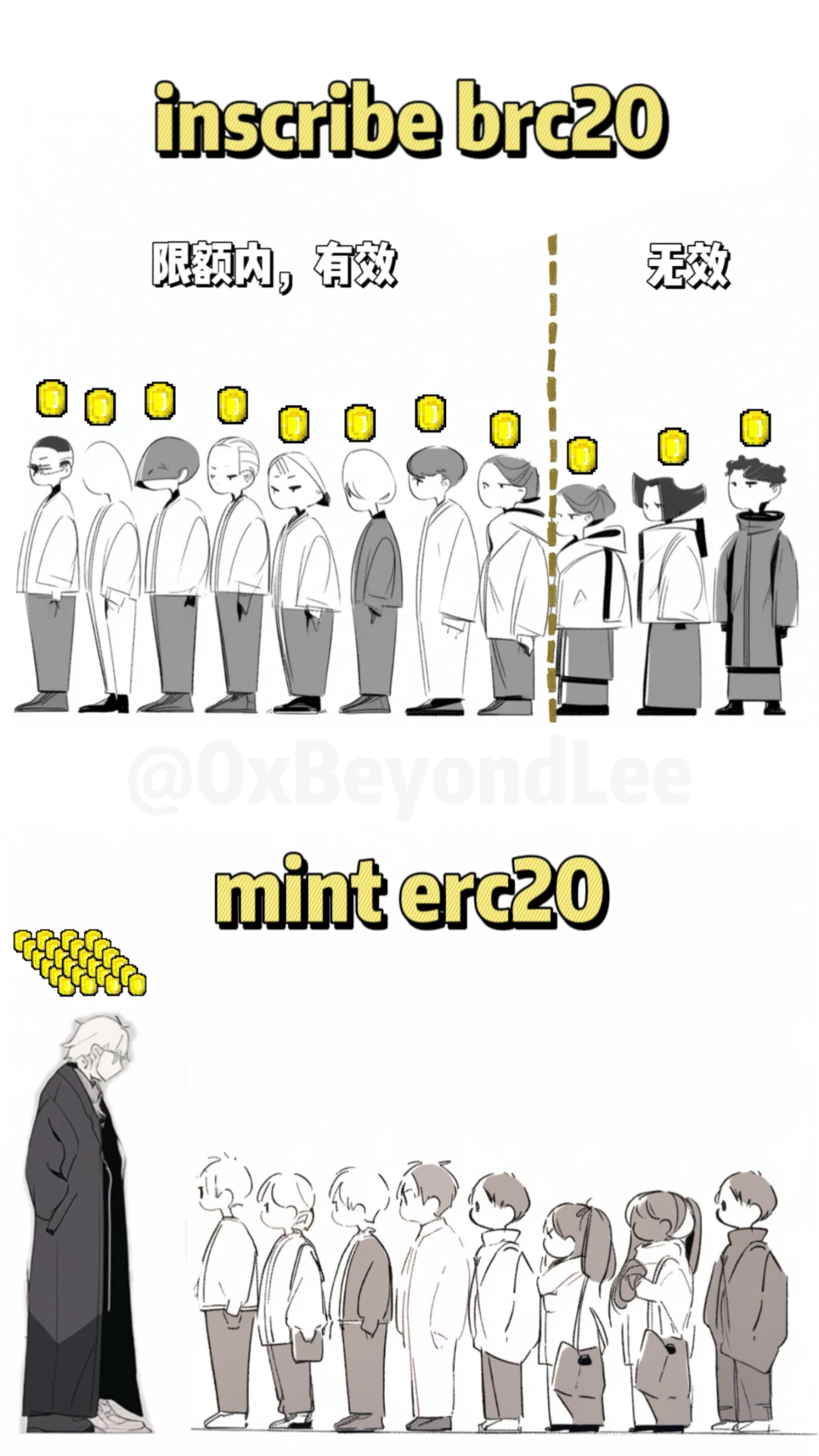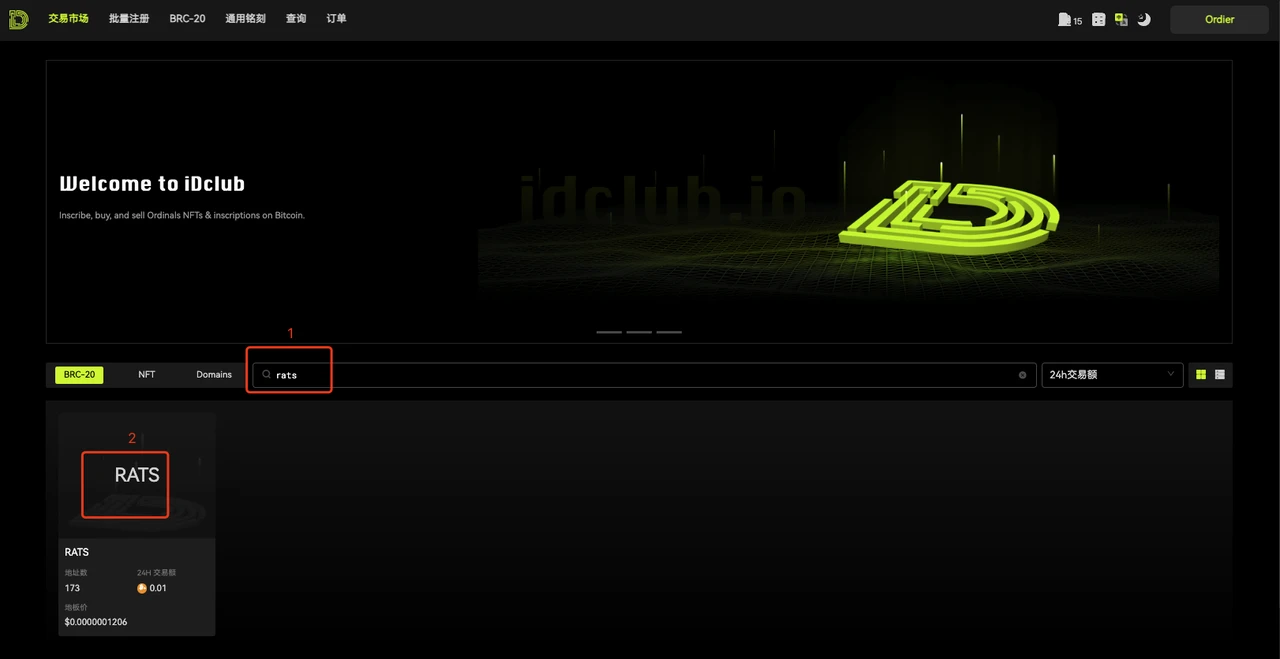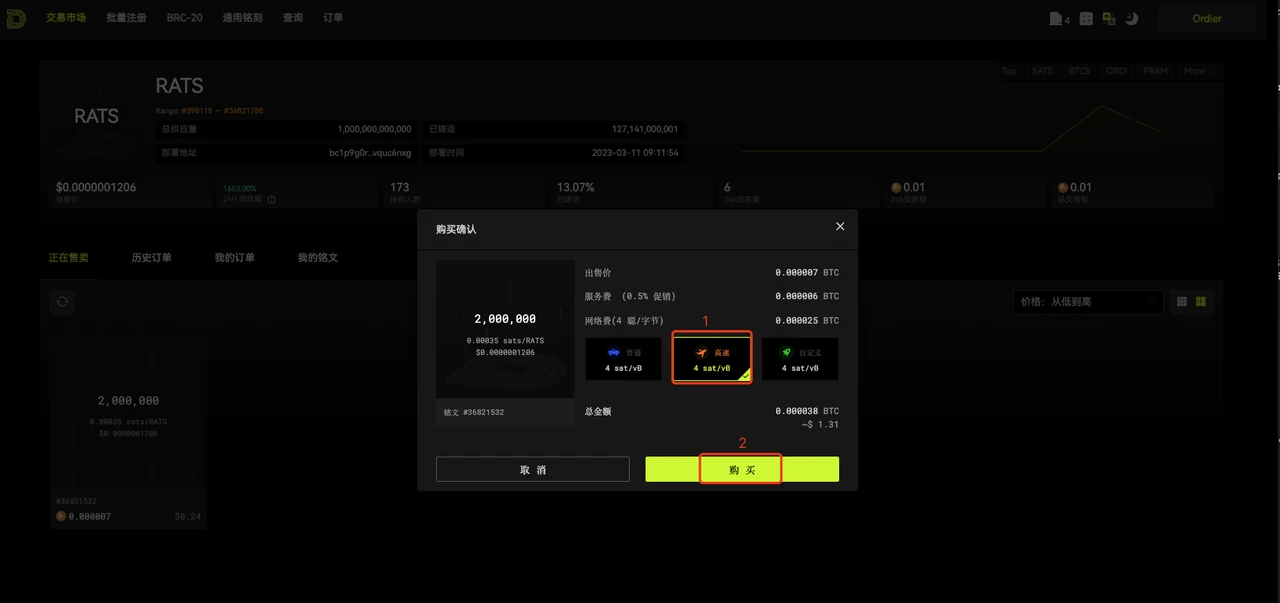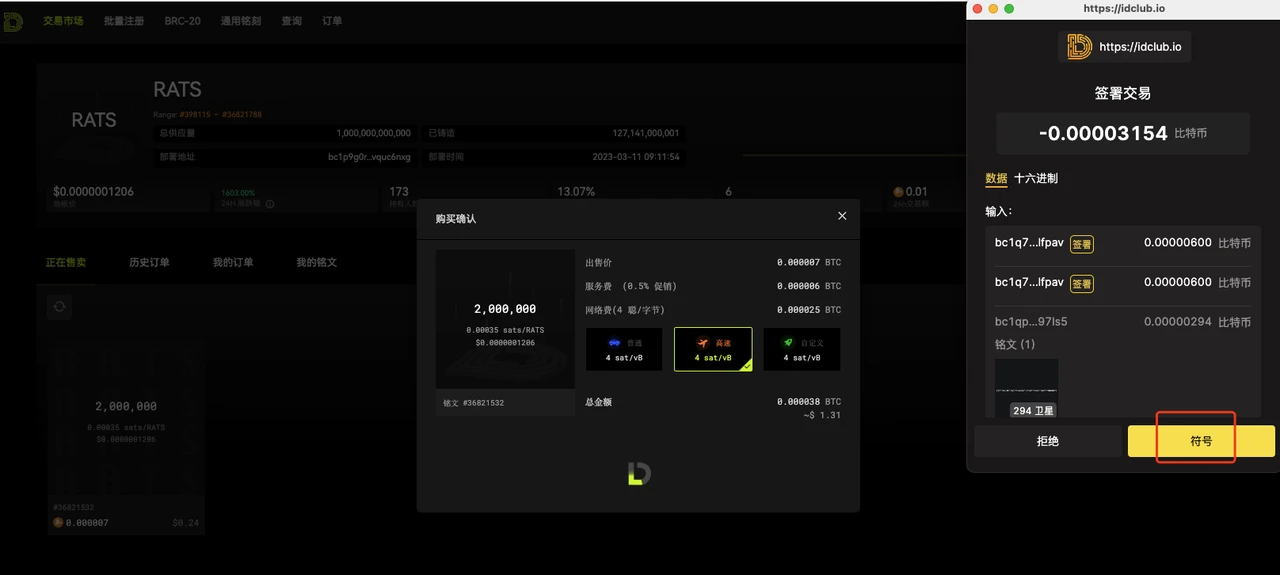1. What are Ordinals?
Ordinals protocol is a system for numbering Satoshis (the smallest unit of Bitcoin, 1BTC=100,000,000 Satoshis) based on the order in which they were mined, and tracking them in transactions. For example, the first Bitcoin mined is numbered from 1 to 100,000,000.
Numbered Satoshis become unique and no longer homogenized. Each Satoshi is now unique.
At the same time, Satoshis are transferred from transaction inputs to transaction outputs based on a first-in, first-out principle. The numbering and transfer (transaction) schemes both depend on order, with the numbering scheme depending on the order in which Satoshis were mined, and the transfer scheme depending on the order of transaction inputs and outputs. Therefore, this scheme is named the Ordinals protocol.
2. What are Inscriptions?
"Inscriptions" is a protocol that allows attaching arbitrary content (such as text, images, videos, HTML files, etc.) to individual Satoshis, thereby transforming them into native digital artworks on the Bitcoin blockchain.

Image source: Internet
The process of engraving inscriptions is achieved by sending transactions with Taproot scripts to write arbitrary content into the transaction. Once the transaction is confirmed on the blockchain, the inscribed Satoshi becomes an inscription. The information is permanently recorded on the Bitcoin (Satoshis). In simple terms, an inscribed Satoshi becomes an inscription.
Once an inscription is created, it is bound to the specific Satoshi it was inscribed on. However, to prevent dust attacks, Bitcoin has a minimum transaction limit, with the minimum limit for a single transaction being 294 Satoshis. Therefore, inscriptions are not bound to a single Satoshi, but to at least 294 Satoshis. However, tracking inscriptions does not involve tracking the numbering of these 294 Satoshis, but rather tracking the numbering of the first Satoshi. This way, the storage, transfer, and trading of inscriptions only require tracking specific numbered Satoshis.
Although traditional NFTs share some similarities with Ordinals in some aspects, there are several key differences. NFTs usually use smart contracts to create and manage assets on blockchains such as Ethereum, Solana, and BNB Smart Chain, and sometimes the assets they represent may be hosted elsewhere. In contrast, Ordinals are directly recorded on individual Satoshis and then included in the Bitcoin blockchain. Ordinals reside entirely on the blockchain, without the need for sidechains or separate tokens. In this sense, Ordinals recording inherits the simplicity, immutability, security, and durability of Bitcoin itself.
3. What is BRC-20?
BRC-20 is a standard for token issuance based on Ordinals. The issuance and minting of BRC-20 tokens are also the process of engraving inscriptions. It is also necessary to inscribe specific formatted text onto Satoshis.
This is the inscription of Ordi's token deployment information, which is to inscribe this content onto Satoshis. Once this transaction is confirmed, the deployment of the inscription is completed. Here, "p" specifies that it is BRC-20, "op" is the action type, and in this case, "Deploy" is the deployment. Other actions include "Mint" for minting and "Transfer" for transfer. "max" represents the total quantity of tokens, and "lim" represents the maximum quantity of tokens included in a single inscription.

BRC-20 uses JavaScript Object Notation (JSON) to deploy token contracts, as well as to mint and transfer tokens. Tokens can be denominated in Satoshis and then traded or exchanged with other tokens, just like any other tokens.
4. What is the relationship between Ordinals and BRC-20?
Ordinals provide the underlying technology for recording data on the Bitcoin network, while BRC-20 provides the rules for creating and managing tokens using this technology. BRC-20 uses the Ordinals protocol to record the data representing these tokens on the blockchain.
In simple terms, Ordinals assigns numbers to Satoshis, making each Satoshi unique. Then, tracking the numbering of Satoshis achieves the recording and tracking of Satoshis. By inscribing information in inscriptions, Satoshis become inscriptions. Recording and tracking the numbering of the Satoshis corresponding to the inscriptions completes the storage, recording, and trading of inscriptions.
BRC-20 specifies the format of information inscribed on Satoshis, which constitutes the rules for deploying, minting, and transferring BRC-20 tokens. This establishes the BRC-20 token standard. Following a specific format allows for the deployment, minting, and transfer of BRC-20 tokens. The deployment and minting of tokens both follow the "First is First" principle, based on the first deployment and the first minting. For example, if Ordi is deployed on March 8th, no new Ordi can be deployed afterward. If the total quantity is 21,000,000, only the first 21,000,000 tokens minted are valid. Although minting can continue after completion, it is considered invalid.
5. What are the differences between Ordinals' BRC-20 tokens, NFTs, and domain names and Ethereum's ecosystem of token NFTs and domain names?
Tokens: BRC-20 uses proof of work on the Bitcoin blockchain, while ERC-20 uses proof of stake on the Ethereum blockchain. The BRC-20 token standard also does not support smart contracts. BRC-20 transactions are based on PSBT technology, while ERC-20 token transactions are based on smart contracts. There are also significant differences in their issuance and minting. Refer to the following image for details.

Image source: Internet
NFTs: Ordinals' NFTs and traditional NFTs both possess the characteristics of uniqueness and immutability. However, from a technical design perspective, Ordinals differs from traditional NFTs. Ordinals' NFTs exist only on the blockchain and are completely immutable, while NFTs can exist off-chain.
NFTs on Ethereum usually point to off-chain data on the Interplanetary File System (IPFS), a decentralized file storage system. It is somewhat like the blockchain's hard drive—capable of being altered using dynamic metadata. To illustrate this, some NFT projects update the metadata of individual NFTs to improve image quality. They may even require their holders to click the "Refresh Metadata" button on OpenSea to obtain a new, higher-quality image.

Image source: Internet
In Rodarmor's vision, NFTs are "incomplete" because many of them require off-chain data. On the other hand, Ordinals are "complete" because all data is directly recorded on-chain. This is why Rodarmor refers to them as digital artworks rather than Bitcoin NFTs. Additionally, NFTs usually come with creator royalties, while digital artworks do not.
Ordinals can be minted directly on the Bitcoin blockchain, while NFTs usually require a separate minting process on a smart contract platform. All of this indicates that the numbering on Bitcoin may not only signify a cultural shift for Bitcoin—it may actually be a technical improvement on NFTs.
Another key difference for Bitcoin ordinals is the derivation of rarity and the pricing of NFTs. For traditional Ethereum-based NFTs, creators usually define the rarity of the NFT and subsequently its price.
However, for Bitcoin ordinals, pricing will be defined by key moments represented by Bitcoin blocks. The initial 1,000 or 10,000 inscriptions may still be cherished by collectors. The founder of Ordinals has proposed a simple framework, where key events will determine the rarity of Satoshis and the inscriptions engraved on them. Domain Names: Ethereum Name Service (ENS) is similar to DNS, but it manages website domain names in a more secure and decentralized manner, and can be used to send ETH and ERC-20 tokens. BTC ecosystem domain names are more decentralized, with advantages such as full on-chain process, independent completion, and permanent preservation once minted. ENS requires renting, while "most" domain names in the BTC ecosystem do not require renewal and are yours forever after a single minting. Overview and Introduction of Ordinals Ecosystem Products: Wallets, Trading Markets 1. Wallets 1) Unisat UniSat Wallet is a Chrome extension wallet for the BTC ecosystem, similar to MetaMask, helping users store, mint, and transfer BRC-20 tokens, as well as buy and sell BTC, NFTs, and domain names. 2) xverse Xverse is a web3 Bitcoin wallet. The wallet is developed on the Stacks (STX) platform and secured by Bitcoin, allowing for token exchange, NFT trading, access to DeFi, and other decentralized applications. It now also supports Ordinals. 3) OKX wallet OKEx Web3 Wallet is a non-custodial, decentralized multi-chain wallet with a built-in DEX for cross-chain coin swaps, a one-stop DeFi investment tool, and a heterogeneous multi-chain aggregation trading platform. It currently supports Ordinals. 2. Trading Markets 1) iDclub iDclub is a professional Ordinals trading market, one of the earliest to enter the Ordinals ecosystem. It offers very affordable minting and trading fees, providing the most cost-effective Ordinals NFTs, BRC-20 tokens, and domain name minting and trading services. It has full functionality. 2) Magic Eden on Bitcoin Magic Eden On Bitcoin is a vertical trading market for the BTC ecosystem by Magic Eden, supporting the issuance and trading of NFT assets in the Ordinals ecosystem, but currently does not support the trading of BRC-20 token assets. 3) Unisat Unisat has a comprehensive Ordinals trading market, offering minting and buying/selling of domain names, NFTs, and BRC-20 tokens. It has also launched BRC-20 SWAP, currently in beta testing. 7. How to Mint BRC-20 Tokens? 1) Preparations Many newcomers are unsure where to start with minting and trading BRC20 tokens. This article provides a detailed guide on how to mint, sell, and buy inscriptions! Before starting, a simple explanation of the two operations is provided. Minting: Tokens that have not reached 100% completion can be minted, commonly known as engraving inscriptions. Selling: Selling tokens, primarily transferring minted inscriptions before selling. Before proceeding, install wallet plugins in the browser (Chrome is recommended). The list of wallets supported by iDclub on the desktop is as follows: Unisat Wallet plugin: [link] Xverse Wallet plugin: [link] OKX Wallet plugin: [link] 2) How to Mint BRC-20 Tokens? - Enter iDclub.io and connect the wallet in the top right corner of the page. - Click on BRC-20 in the top left corner of the page and select BRC tokens. - Navigate to the BRC-20 minting page, fill in the token name, the quantity of tokens in a single inscription package (default maximum), and the number of packages. - Confirm the quantity and click next to proceed with inscription minting. - Confirm the receiving address, gas fee, and the amount of reserved Satoshis per inscription. - After ensuring the accuracy of the transaction details, click on "Pay" to proceed with minting and confirm the payment. - After successful payment, the page will automatically redirect to the order page, displaying the order ID, amount, gas fee at the time of order submission, quantity, inscribed content, receiving address, order time, payment status, and inscription progress.- Acceleration: When the transaction fee (gas fee) is too low, it may result in transaction failure or slow confirmation. In this case, you can accelerate the order. Note: Acceleration will incur additional fees. - After on-chain confirmation, the order status changes to "engraving completed," and you can see the minted inscriptions in your wallet. - How to Sell BRC-20 Tokens: 1. Selling BRC-20 tokens is different. Selling inscribed tokens requires engraving transfer inscriptions. Below is an example using iDclub to demonstrate how to sell BRC-20 tokens: 2. Click on the wallet address in the connected wallet position to access the personal asset page. 3. Click on "My Inscriptions" to display all inscriptions in the wallet. To list them for sale, you need to engrave transfer inscriptions first. 4. Select the transfer quantity and number of transfers. The transfer quantity can be customized based on the desired quantity for sale. The batch number refers to how the quantity will be divided. For example, if the transfer quantity is 100 and the batch number is 2, there will be 2 batches of 50 inscriptions each. 5. Select the receiving address, fee rate, and reserved Satoshis. After confirming the information in the pop-up box, click "Sign and Pay" to submit the engraving transfer. 6. After successful submission, the page will automatically redirect to the order details page, displaying the order ID, amount, fee rate, inscribed content, order time, payment status, and other information. - Acceleration: If the transaction fee (gas fee) is estimated to be too low at the time of order submission, it may fail, or if you want to speed up the on-chain confirmation, you can use the acceleration feature. Note: Acceleration will incur additional fees. - After the engraving transfer is completed, return to "My Inscriptions" in the trading market to list the inscriptions for sale. - Click on "List" and enter the sale price in the pop-up box that appears in the lower right corner. After confirming the listing price, click "List Now." - After confirming the information, sign and complete the listing. Update the order price by entering the adjusted price and signing to confirm. Once confirmed, the price update is completed, and you can wait for the order to be purchased. - How to Buy BRC-20 Tokens: - Inscriptions: You can buy and mint inscriptions. Minting is supported when the engraving progress is not at 100%. When the engraving progress reaches 100%, you can buy them in the trading market. When someone lists inscriptions for sale in the trading market, you can buy them without waiting for the engraving progress to reach 100%. The price for direct purchase may be higher or lower than the minting cost, depending on the current price at the time of purchase.- Search for the inscriptions you want to buy, using RATS as an example. Click on the inscription to enter the details list, find a suitable listing price, and click "Buy."   - Confirm the transaction fee rate (GAS fee) for the purchase. The default is high speed, and it supports customization. (⚠️ Customized GAS fees should not be too low, as it will result in excessively long transaction confirmation times.) Confirm the signature.  - When making the purchase, a wallet confirmation will pop up. After confirming that the information is correct, click "Confirm." After confirmation, wait for on-chain confirmation. Once confirmed on-chain, the purchased inscriptions will be displayed in the wallet. Purchase completed ✅  - For more professional knowledge and information about Ordinals, you can also follow our Twitter @idclub_ord. - [Disclaimer] The market carries risks, and investment should be cautious. This article does not constitute investment advice, and users should consider whether any opinions, viewpoints, or conclusions in this article are suitable for their specific situation. Investment based on this information is at your own risk.免责声明:本文章仅代表作者个人观点,不代表本平台的立场和观点。本文章仅供信息分享,不构成对任何人的任何投资建议。用户与作者之间的任何争议,与本平台无关。如网页中刊载的文章或图片涉及侵权,请提供相关的权利证明和身份证明发送邮件到support@aicoin.com,本平台相关工作人员将会进行核查。




